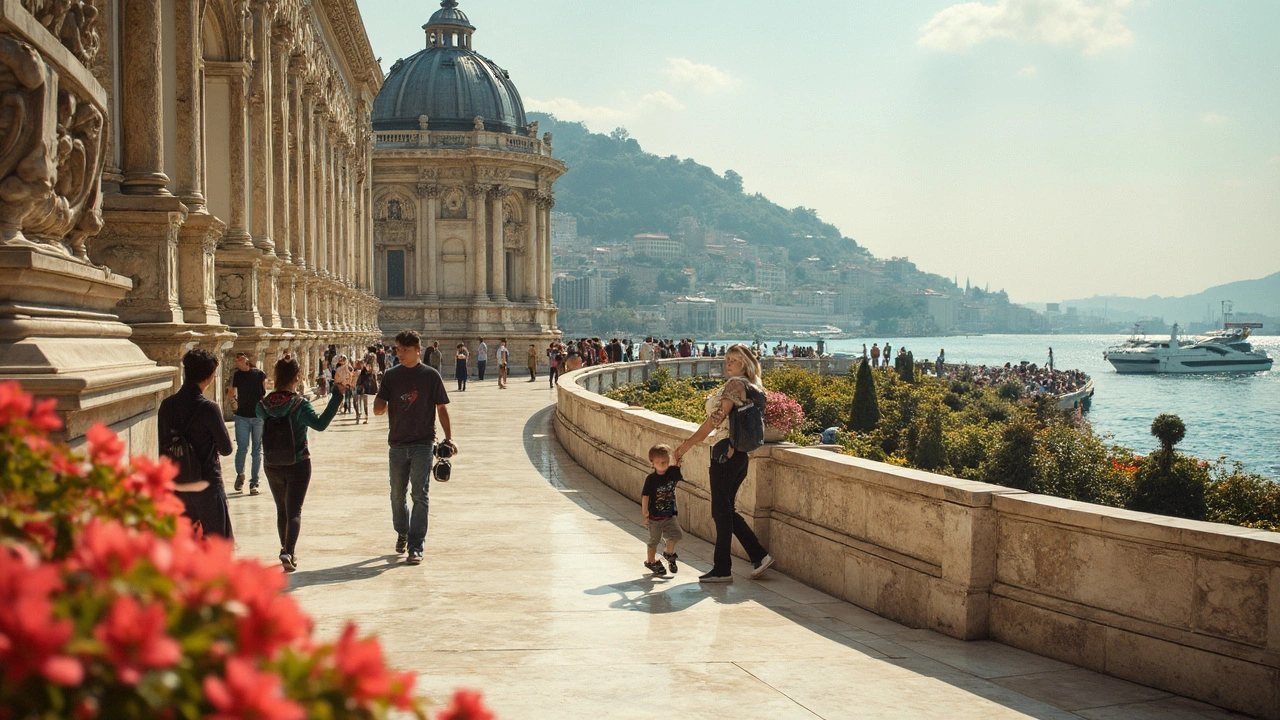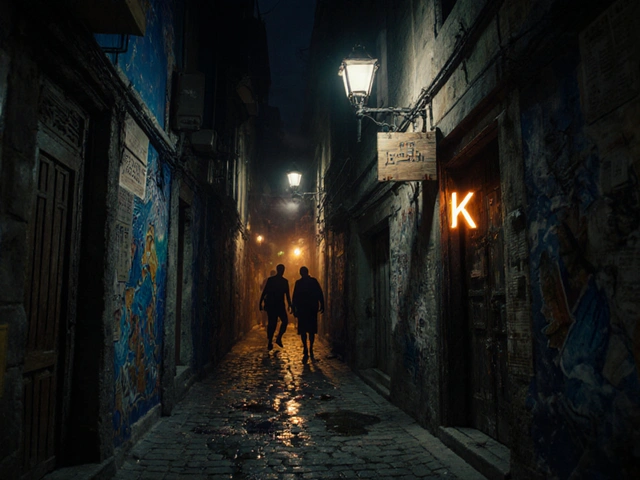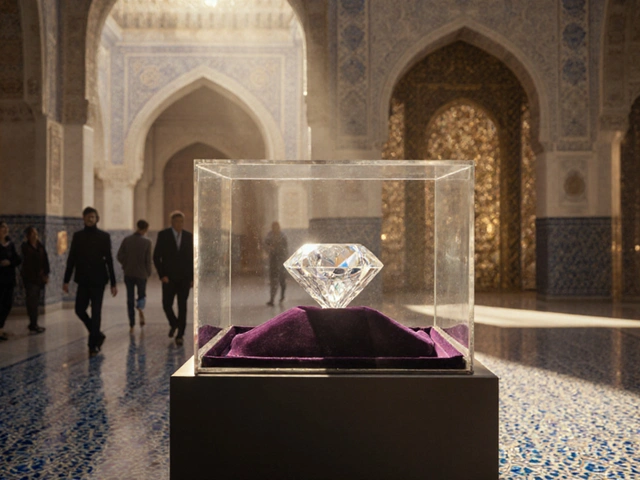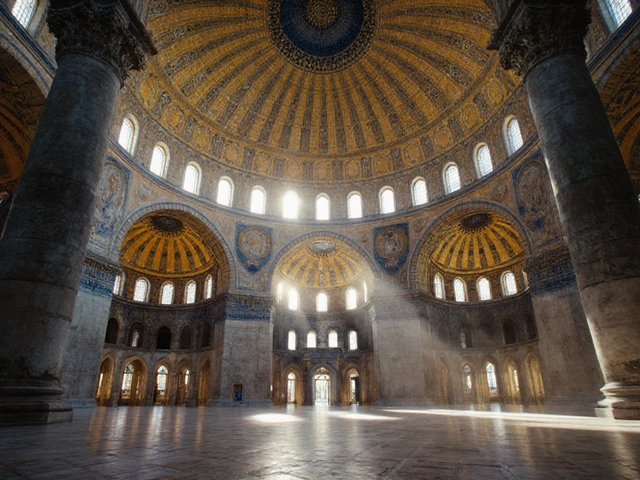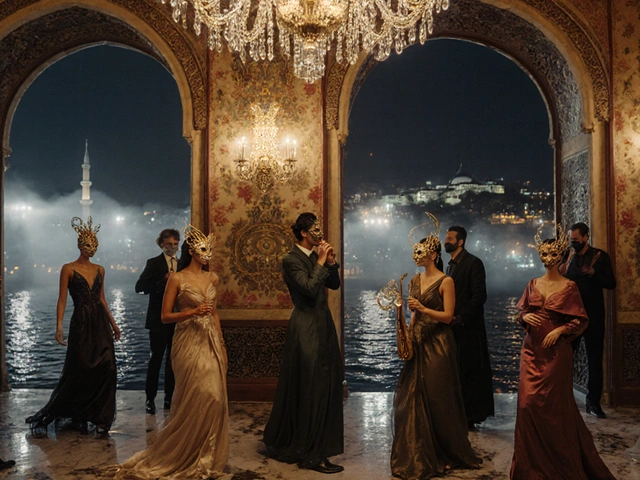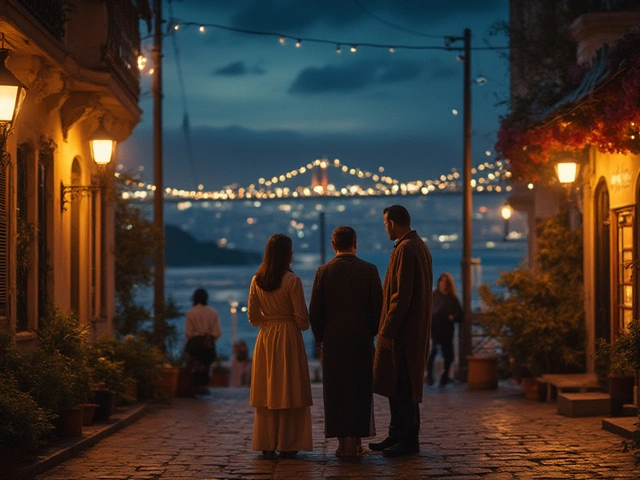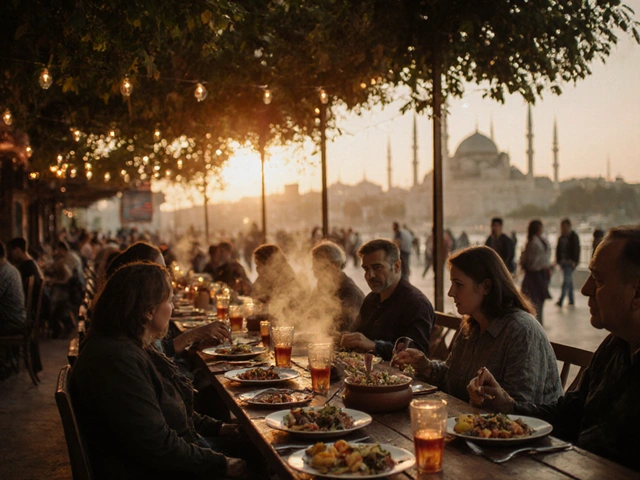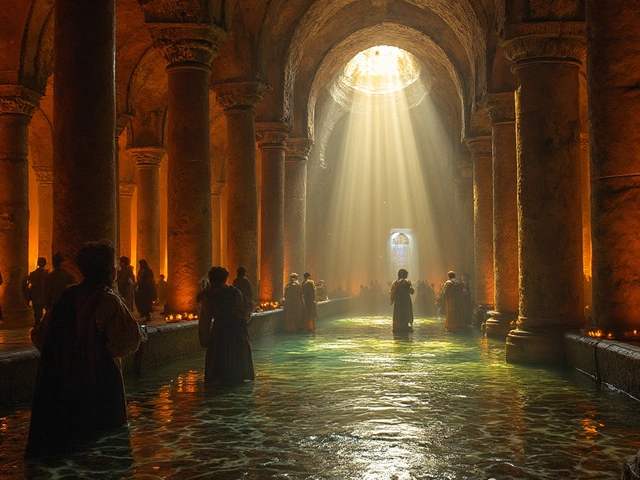When you’re stuck in traffic on the Beşiktaş coast road, it’s easy to miss that you’re passing right by one of Istanbul’s greatest treasures: Dolmabahçe Palace. Hidden behind high metal gates, this sprawling marvel sits steps away from the chaos of Dolmabahçe Caddesi, yet feels worlds apart.
This isn’t just another reddish villa or old mansion like the ones sprinkled along the Bosphorus. Dolmabahçe hammers Istanbul’s story into marble, gold, and chandeliers—even the air inside feels different, like it has secrets.
For anyone living in Istanbul, or just passing through, skipping Dolmabahçe is like ignoring the Grand Bazaar. It’s where the Ottoman Empire showed off its last gasp of power but also quietly said goodbye. The huge clock tower outside? It’s set permanently at 09:05, the exact minute Atatürk died here—something every Istanbulite nods to, whether they stop by for a selfie or rush past on their way to a vapur ferry.
- A Glimpse into Ottoman Grandeur
- Behind the Palace Walls: Stories and Scandals
- Dolmabahçe’s Architectural Marvels
- The Palace Experience: Getting the Most Out of Your Visit
- How Dolmabahçe Shaped Istanbul’s Modern Vibe
A Glimpse into Ottoman Grandeur
Picture Istanbul in the mid-1800s: the Ottoman sultans wanted a palace that could keep up with the rest of Europe and send a message to the world. That’s exactly how Dolmabahçe Palace came to be. Sultan Abdülmecid I, feeling a bit tired of Topkapı’s old-fashioned corners, decided in 1843 that it was time for a global upgrade. He hired Garabet Balyan and his genius architect son, Nigoğayos, leaders of Istanbul’s famous Balyan family, to design a palace unlike any seen before—mixing Ottoman flair with baroque, rococo, and neoclassical twists.
The palace was finished in 1856 and cost at least five million Ottoman gold lira—a price tag so wild it sent the empire into debt. The Balyan architects didn’t hold back: inside, you get 285 rooms, 44 halls, 68 toilets, and six Turkish baths, every one dripping with gold leaf and crystal. It’s the largest palace in Turkey, and when locals talk about lavish Bosphorus mansions, Istanbul's Dolmabahçe sets the gold standard.
The palace’s Ceremonial Hall is straight out of a royal drama, with a 36-meter-dome and a chandelier that weighs 4.5 tons—the world’s biggest Bohemian crystal chandelier, a gift from Queen Victoria herself. Imagine standing under more than 750 light bulbs as you look across the Bosphorus; this, not the Grand Bazaar, is where the sultans met foreign ambassadors and staged their power plays.
Here’s a table for perspective on just how massive Dolmabahçe is compared to Istanbul standards:
| Feature | Dolmabahçe Palace | Topkapı Palace |
|---|---|---|
| Rooms | 285 | Less than 400 (spread over more open areas) |
| Main Hall Chandelier Weight | 4.5 tons | N/A |
| Year Completed | 1856 | Mid-15th century |
| Architectural Style | Ottoman-European blend | Classic Ottoman |
If you ever wondered why Istanbul locals see Dolmabahçe as the place for royal Instagram shots, this is why. Families still stroll by its gates each weekend, teens gather in the park just to snap the palace in the background, and even on weekdays, wedding photographers are everywhere. For more than 150 years, Dolmabahçe has been part of Istanbul’s DNA, bridging history and everyday life.
Behind the Palace Walls: Stories and Scandals
Dolmabahçe Palace has seen more drama than most Istanbul soap operas. The walls are thick with secrets, and if you listen close, you’ll hear echoes of everything from lavish parties to political intrigue—sometimes both in the same night.
Let’s start with Sultan Abdülmecid, the guy who decided the Topkapı Palace was too old-school and built Dolmabahçe to project modern Ottoman power. The new palace cost 5 million Ottoman gold liras at the time—about 35 tons of gold. Treasury officials shuffled bills across the marble floors here as the Empire’s debts stacked up. Rumor says some priceless items, like gifts from foreign royals, vanished mysteriously during chaotic final days. Staff would hustle valuables across the Bosphorus in rowboats at night to keep them out of the hands of invaders or thieves.
A lot went down here after Sultan Abdülmecid too. Sultan Abdülaziz, known for his short temper, was found dead under strange circumstances. The story handed to the press? Suicide. Many locals still trade theories about foul play, as the details never added up. The palace guards were shuffled, the coroner’s report was sketchy, and gossip spread faster than Turkish coffee cools down.
And then there’s Atatürk, the founder of modern Turkey. He spent his last days at Dolmabahçe in Room 71. School kids from Istanbul visit every November, leaving carnations under the clock frozen at 09:05, the moment he passed. If you’re touring, pay attention—his simple bedroom stands in sharp contrast to the gold-leaf ceilings elsewhere, quietly echoing big changes in the country.
For quick reference, here’s a straightforward rundown of the palace’s most talked-about secrets and infamous moments:
- Istanbul’s most expensive construction: Dolmabahçe practically bankrupted the Empire.
- The Imperial Harem here was both a home and a rumor factory—stories about palace intrigue and rivalries abound.
- After the Empire’s fall, British troops briefly used the palace as their command center.
- The world’s biggest Bohemian crystal chandelier weighs 4.5 tons and hangs in the Ceremonial Hall.
| Event | Year | Impact |
|---|---|---|
| Construction Completed | 1856 | Ottoman Empire’s image boost, but costly |
| Death of Sultan Abdülaziz | 1876 | Controversial, suspected palace coup |
| Atatürk’s Passing | 1938 | National mourning, room preserved as memorial |
| Palace becomes museum | 1984 | Opened for public tours and history buffs |
If you walk the halls, keep an ear open. Guides love sharing these stories—sometimes with a wink, because even decades later, Istanbulites debate which rumors were true. Don’t rush; these tales make every corner come alive.
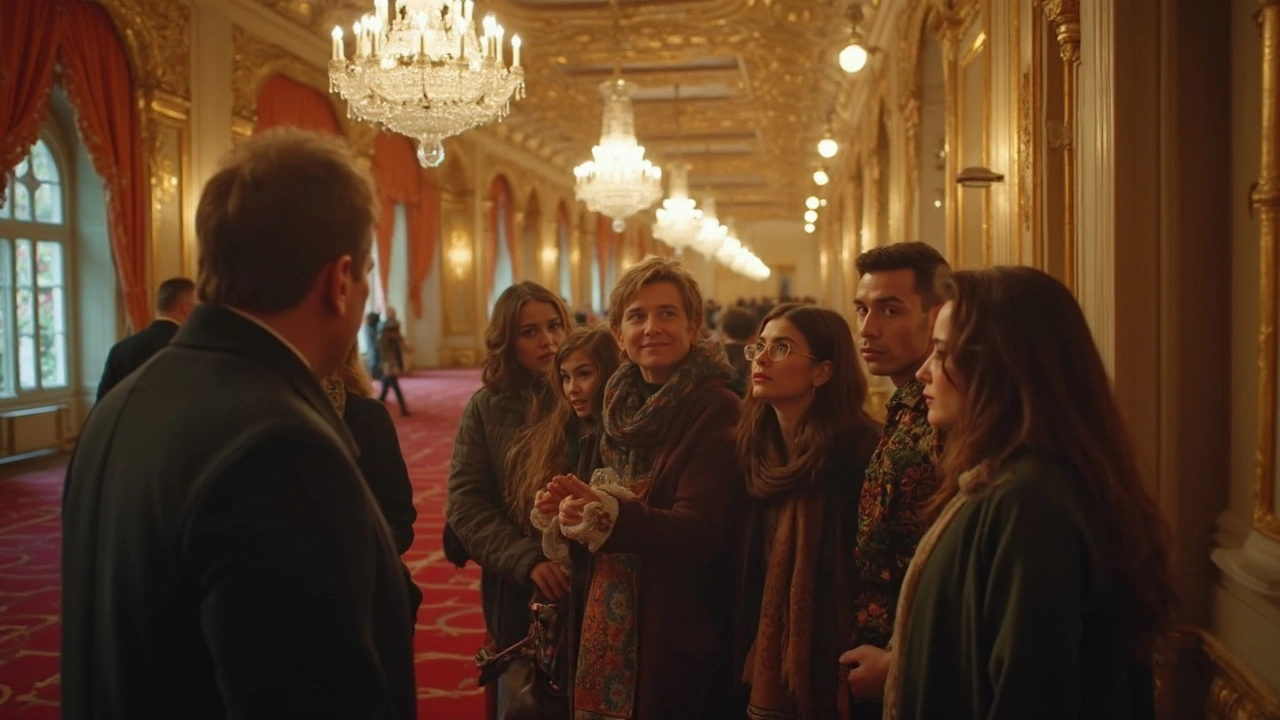
Dolmabahçe’s Architectural Marvels
If you stand at the iron gates of Dolmabahçe Palace, you’ll notice pretty quickly: nothing here looks like the old Topkapı buildings just up the Bosphorus. This place was built to impress outsiders, and it’s as flashy as anything you’ll find in Paris or London. The palace mixes European and Ottoman styles in a way that’s totally unique to Istanbul.
The architect, Garabet Balyan, worked with his son to finish the palace in 1856—right at the time when the Ottoman Empire wanted to prove it was still in the game with the big European powers. The Balyan family, by the way, also designed other local icons like Ortaköy Mosque and the Beylerbeyi Palace, so they weren’t messing around. Dolmabahçe is massive: the main building alone stretches 285 meters along the coast. There are 285 rooms, 46 halls, and 6 hammams.
When you go inside, the first thing that hits you is the Ceremonial Hall. This room is famous for its huge glass dome and the world’s biggest Bohemian crystal chandelier. It weighs 4.5 tons—yes, tons. Queen Victoria sent it as a gift, and nobody in Istanbul has forgotten about it since.
There’s a lot locals love to point out:
- The grand staircase, also called the "crystal staircase," has banisters made from Baccarat crystal—these things sparkle even on a cloudy winter morning.
- Most ceilings are painted gold, and the floors are Turkish oak parquet, which is still in great shape after almost 170 years.
- You’ll spot French Rococo, Baroque, and Neoclassical influences everywhere, especially around the sultan’s halls and the huge white columns.
- The palace has its own mosque, clock tower, and even a secret tunnel that leads toward the Kabataş tram stop, which locals like to talk about but rarely see.
Check out these fast facts about the palace’s unique design and features:
| Detail | Data |
|---|---|
| Rooms | 285 |
| Halls | 46 |
| Chandeliers | Over 750 |
| Main Facade Length | 285 meters |
| Largest Chandelier Weight | 4,500 kg |
If you’re touring as a group, ask your guide about the hidden features, like the harem section where the sultan’s family lived, or the secret passages staff used to avoid being seen. No photo really does the place justice—standing in the Ceremonial Hall while sunlight bounces off the giant chandelier is something every Istanbul resident should do at least once.
The Palace Experience: Getting the Most Out of Your Visit
Getting the most out of Dolmabahçe Palace means knowing how to dodge the long ticket line, choosing the right route, and catching details locals usually look out for. If you’re visiting on a weekend or in the summer, expect a serious queue, especially after lunchtime. Skip-the-line tickets can be a game changer—you can buy them through the official website or at kiosks in Kabataş and Beşiktaş. Students and Turkish citizens get a solid discount but remember to bring your ID if you want that.
Your basic ticket covers the Selamlık (public halls) and the Harem section. Audioguides are available free with your ticket, and trust me, you’ll want them—even locals learn new stuff about the last Ottoman sultans every time they visit. Guided tours in Turkish and English usually start every half hour, and you’ll spot them gathering near the giant Bohemian crystal staircase. That spot is Instagram gold, by the way.
- Backpacks and large bags? Not allowed inside—use the lockers near the ticket booth.
- Photography is tightly restricted inside the main halls. The staff do ask people to put phones and cameras away, so be ready for a bit of old-school sightseeing.
- The best time to visit is early on a weekday when it’s way less crowded and a lot cooler inside.
- The palace closes on Mondays, so plan around that—public holidays can throw schedules off, too.
It helps to know just how big the place actually is. Besides the Selamlık and the Harem, you can relax in the gardens facing the Bosphorus, which are free even if you don’t buy a palace ticket. If you’ve got kids or grandparents tagging along, they’ll love watching the swans near the ornate gates. And if you’re hungry, there’s a reasonably priced outdoor cafe inside the grounds. Their Turkish tea and simit are perfect if you want a break without leaving the palace.
The main highlights usually catch everyone’s eye, like the world’s largest Bohemian crystal chandelier (weighing 4.5 tons!) in the Ceremonial Hall. But don’t skip the clock collection—locals nod with respect to the clocks stopped at 09:05 throughout the palace as a tribute to Atatürk. If you’re in a rush, here’s a quick cheat sheet for what not to miss:
- The Ceremonial Hall and its chandelier
- The grand staircase (it’s not as famous as it should be)
- Atatürk’s bedroom—simple, quiet, and full of history
- The palace’s main entrance gate with its over-the-top neo-baroque style
| Section | Opening Hours | Standard Ticket Price (TRY) | Discounts Available |
|---|---|---|---|
| Palace & Gardens | 09:00 – 18:00 (Closed Mon) | 650 | Students, Turkish citizens, seniors |
| Selamlık Only | – | 500 | – |
| Harem Only | – | 300 | – |
Before you bail, check the gift shop for Bosphorus-themed souvenirs and Turkish brands like Paşabahçe glass. There’s also a tiny bookstore with Atatürk biographies and palace history—great gifts if you want to show off that you know your Istanbul facts.
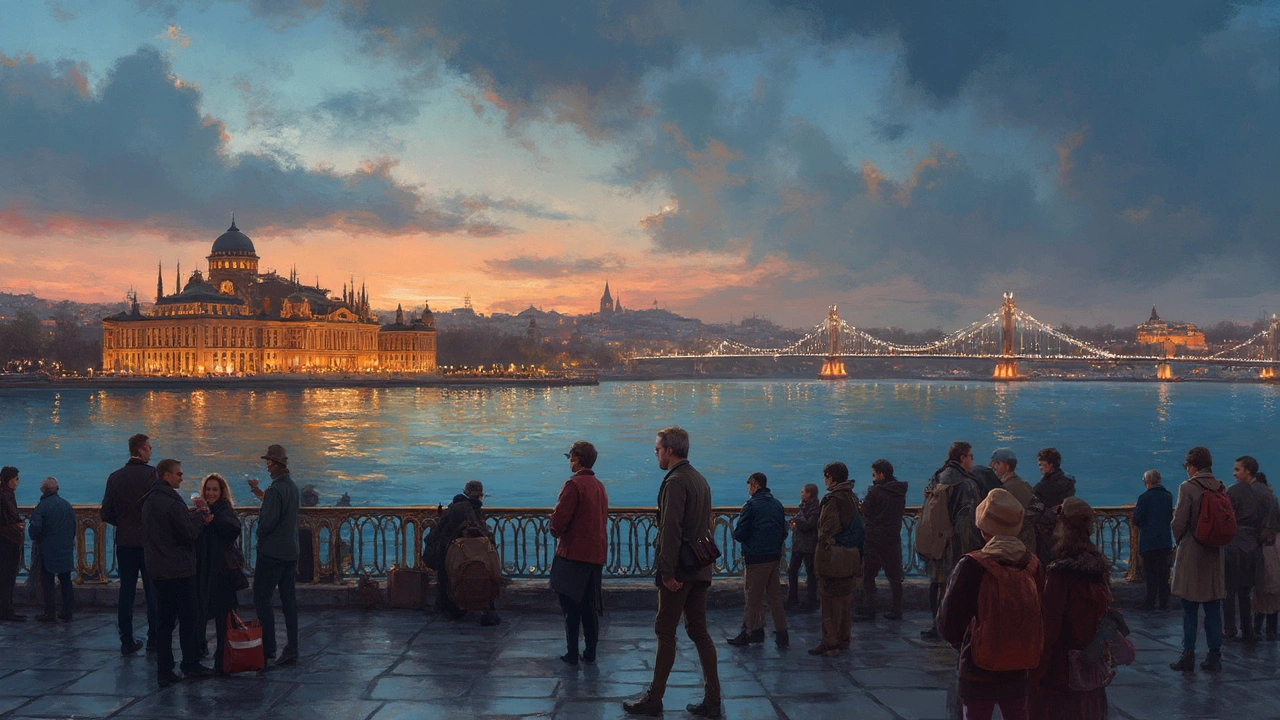
How Dolmabahçe Shaped Istanbul’s Modern Vibe
Dolmabahçe Palace isn’t just a flashy spot for tourists or a hangout for history buffs. It played a serious role in flipping Istanbul from an Ottoman center into a modern, almost European-facing city. Today, its mark pops up all over the place—from the way locals see their city, to big city plans, and even how people spend a Sunday on the Bosphorus.
When the palace first popped up in the mid-1800s, it was the symbol of all things new and Western for the sultans. They wanted a break from the stuffy, old Topkapı vibe and chose crystal, velvet, and furniture straight from Paris and London. The style stuck. Modern art galleries like Istanbul Modern now use the same mix of local and international tastes. Even chic neighborhoods like Nişantaşı have that European influence, but with an Istanbul twist.
The palace didn’t stop influencing the city when the sultans left. Mustafa Kemal Atatürk used Dolmabahçe as his main base for government work when he was in Istanbul. That decision still matters. Many government offices, the Istanbul Governor’s Office, and other official spots around Beşiktaş and Kabataş reflect this shift—official business in Istanbul got a more modern, open air.
When it comes to culture, people still head here for Istanbul’s big moments. The palace hosts concerts, art events, and even fancy weddings. If you’ve ever watched an Istanbul Biennial opening, you’ll see Dolmabahçe buzzing with international artists and locals mixing it up in spaces that once belonged just to royalty.
Want to see real numbers? Take a look at visitor stats for the past year:
| Year | Visitors | Major Events |
|---|---|---|
| 2024 | 1,950,000 | 4 international art exhibitions, 3 high-profile weddings |
The real estate around the palace, from Beşiktaş all the way to Maçka, saw property prices boom after the 2000s, much of it tied to the area’s status and cultural pull. Trendy cafés like Karabatak or local brands setting up shops nearby all get a boost thanks to Dolmabahçe’s reputation.
Here’s how locals make the most of the palace’s influence:
- Pick Sunday mornings for a stroll—the area comes alive with joggers and young families but isn't as chaotic as the busy afternoons.
- If you’re looking for an Instagram shot, the palace’s seaside walkway near the main garden gate is a favorite with Istanbulites (early morning light is the secret).
- Check out events on the National Palaces website. Concert tickets or special exhibitions at Dolmabahçe sell out fast, so keep an eye out, especially in summer.
For Istanbul, Dolmabahçe is more than a building; it’s part of what keeps the city’s old soul beating alongside its new ambitions. Locals know you don’t need to be a history expert to feel it—it’s just a part of the everyday rhythm along the Bosphorus.
